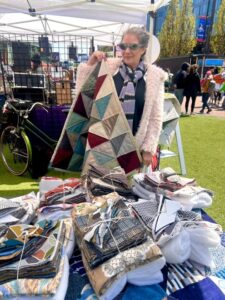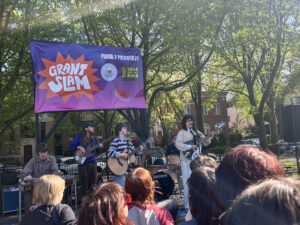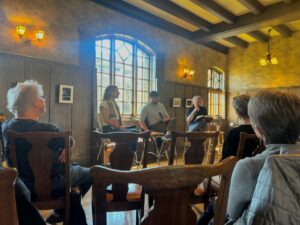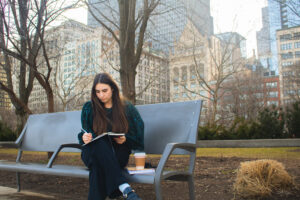The tables in the room were filled with beautiful handmade plates, bowls, vases and earrings. Each item was made less than 100 feet from the display.
The room, normally empty, was turned into a pop-up market where customers can buy the skillfully made art of students at the Hyde Park Art Center. On this particular evening, artist and teacher Brian Parris was teaching a “Throwing and Handbuilding” class for students who were unable to make one or more classes during the ten-week session.
Shelves upon shelves and multiple baker racks were filled with various objects made of clay. Some finished and glazed, others waiting to be fired in the kiln were found in any direction you turned. Large wooden tables were placed around the room, with anything related to ceramics and pottery just a fingertip away.
“At Open Arts, you get people that have all levels of education, or perspective, maybe not even educated, just life perspectives,” Parris said, sitting at one of the large wooden tables. “You just get to be around people that get to express themselves in clay that wouldn’t normally be able to, but they’re from a different point of view than you’re used to.”
In 2022, the Hyde Park Art Center formally launched the “Open Arts” program, offering a multitude of art classes that meet once a week for ten weeks, welcome to both children and adults. The program is run on a “give what you can” donation model, meaning that the class of your choice costs what you are able to give, as a way to create an equitable way for the community to access arts education.
“When we launched spring 2022, we technically only launched about two thirds of all of our programs on site as Open Arts. We weren’t able financially to commit at that time to 100% of our programs being Open Arts, and that’s a bigger financial discussion, but winter 2024 is going to be our first quarter where all of our programs are open arts,” Mike Nourse, director of education at the Hyde Park Art Center, said.
That means an even wider range of classes will be offered to allow for more community members to take part in the program.
“One of the reasons why the tuition model for open arts was created is because we don’t have a single type of student. We’re really a community made up of so many different types of people,” Nourse said.“We wanted to be mindful of that rather than prescribe something for everybody and say everyone’s going to pay this price or everyone’s going to get it for free.
The labor of love is evident among the scene at Open Arts, from the intricate detailing of clay to the deliberation taken when it’s time to pick out the glazing color for their sculptures. Many of the participants work in silence, content in their own world of clay.
Melody Yang, 24, was diligently working on their bowl that was being made to look like a turtle, during their third time attending an Open Arts session. Yang was intrigued by the opportunity to try something new. “I like to paint and draw on my own time, but I want to try and take a class on something that I’ve never really done before,” they said. “I think the programs are really good. I think the instructors are really good and I think the cost and the access to the space is really good.”
An opportunity to try something new without the stressor of money is not a luxury that many have today. The art center sits near the University of Chicago’s campus, and two of the class participants are graduate students.
Rachel Berkebile, 29, is studying to get her masters in divinity at U-Chicago and Luke Dyer, 26, is in the molecular and cell biology graduate program there as well. Both said that this is where they come to let out stress and be creative in a way they don’t normally get to be.
“Having a space to be in my body rather than in my head throughout the week [has been beneficial]. I am also thinking a lot about faith, spirituality and emotions. This is a nice place to just think about my hands,” Berkebile said.
Both Dyer and Berkebile said that they had done research on adult art classes offered around the city and many of the class fees for other programs would have made attending “impossible.”
“I’ve been wanting to take ceramics for a long time,” Dyer said. “It seemed like I just couldn’t afford to right now. But then I found out about Open Arts and was like, ‘Hey, I can do this thing I’ve been wanting to do for years.’”








Be First to Comment